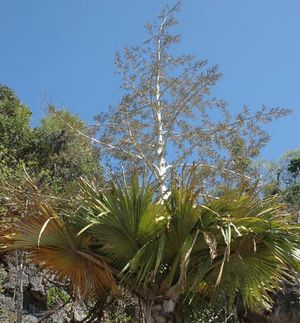
|
| ©John Dransfield
|
| This new species of palm, found recently in northwestern Madagascar, goes out with a bang. Once fully grown, the giant Tahina spectabilis produces a vibrant display of flowers - an act that depletes its nutrients and sparks a slow death. The apparently rare palm lives in areas where habitat has already been degraded, making conservation a priority, scientists say.
|
A couple on a casual stroll in Madagascar recently discovered a new gigantic palm that flowers itself to death.
Taller than a six-story building, with a trunk 1.5 feet (0.5 meter) in diameter, it is the most massive palm discovered to date in Madagascar.
After the plant has rocketed to its full height, a vast candelabra-like structure of flowers develops above its leaves, said William Baker, a scientist with the Royal Botanic Gardens at Kew in London.
Baker and colleague John Dransfield have studied and cataloged the plant.
"The [structure] produces hundreds of thousands of flowers, which drip with nectar when they are open," he said. "It is truly spectacular."
Once pollinated, each flower turns into a fruit. The palm's nutrient reserves then become depleted, the crown collapses, and the tree dies a prolonged death.
The palm is dubbed Tahina spectabilis - in the local language, Malagasy, spectabilis means "blessed" or "to be protected." It's the only known palm in a genus new to science, the researchers say.
Their research appears in the January 17 issue of the
Botanical Journal of the Linnean Society.
Mystery PalmXavier and Nathalie Metz, a French couple who run a cashew plantation in remote northwestern Madagascar, first noticed the mystery palm in September 2006 at the foot of a limestone outcrop.
The enormity of the plant and its large flowers at the top caught their eyes. They posted photos of the palm on the International Palm Society bulletin board in December 2006, where Dransfield and his team soon caught wind of the discovery.
"Clearly this was going to be an extremely exciting discovery, and I just couldn't wait to examine specimens in detail," Dransfield said in a statement.
The data and material Dransfield's team collected suggested that
T. spectabilis belongs to a new genus within the palm tribe
Chuniophoeniceae.
Henk Beentje, an expert on Madagascar flora at the Royal Botanic Gardens, was not involved with the study.
"The fact that [the palm] is described by some of the world's major palm experts makes [the find] pretty solid in my eyes," Beentje said.
"It will enhance our understanding of palm taxonomy, and a new genus is a substantial contribution in its own right - there are less than 200 palm genera known so far," he added.
"There might be new genera lurking elsewhere but I doubt if they would be as spectacular as this one."
Eggs in One BasketThe only three other known genera in this tribe are dotted across the Middle East, Thailand, and China.
The researchers don't know how the newly discovered palm reached the large island off the African continent, or why it destroys itself after flowering.
"The new palm is one of a small, select group of palms that behave in this way," Baker told National Geographic News.
"There is little evidence that the palm flowers frequently, suggesting that it might be rather long-lived and that reproduction is a rare event. It is certainly an extreme way to reproduce - putting all your eggs in one basket."
Conservation EffortsResearchers have identified 90
T. spectabilis specimens so far, most scattered around a tiny patch of limestone forest just 820 feet (250 meters) in length.
"Our analyses suggest that only a very small coastal area would be suitable for the palm, and much of the vegetation in this area is highly degraded," Baker said. "Apart from a lone individual at a nearby village, no other localities are known."
To conserve the palm species, Dransfield and local assistants have set up a patrol to guard the plants.
The Millennium Seed Bank and the Royal Botanic Gardens are also working to sell
T. spectabilis seeds to raise funds for the villagers and help spread the palm.
Reader Comments
to our Newsletter